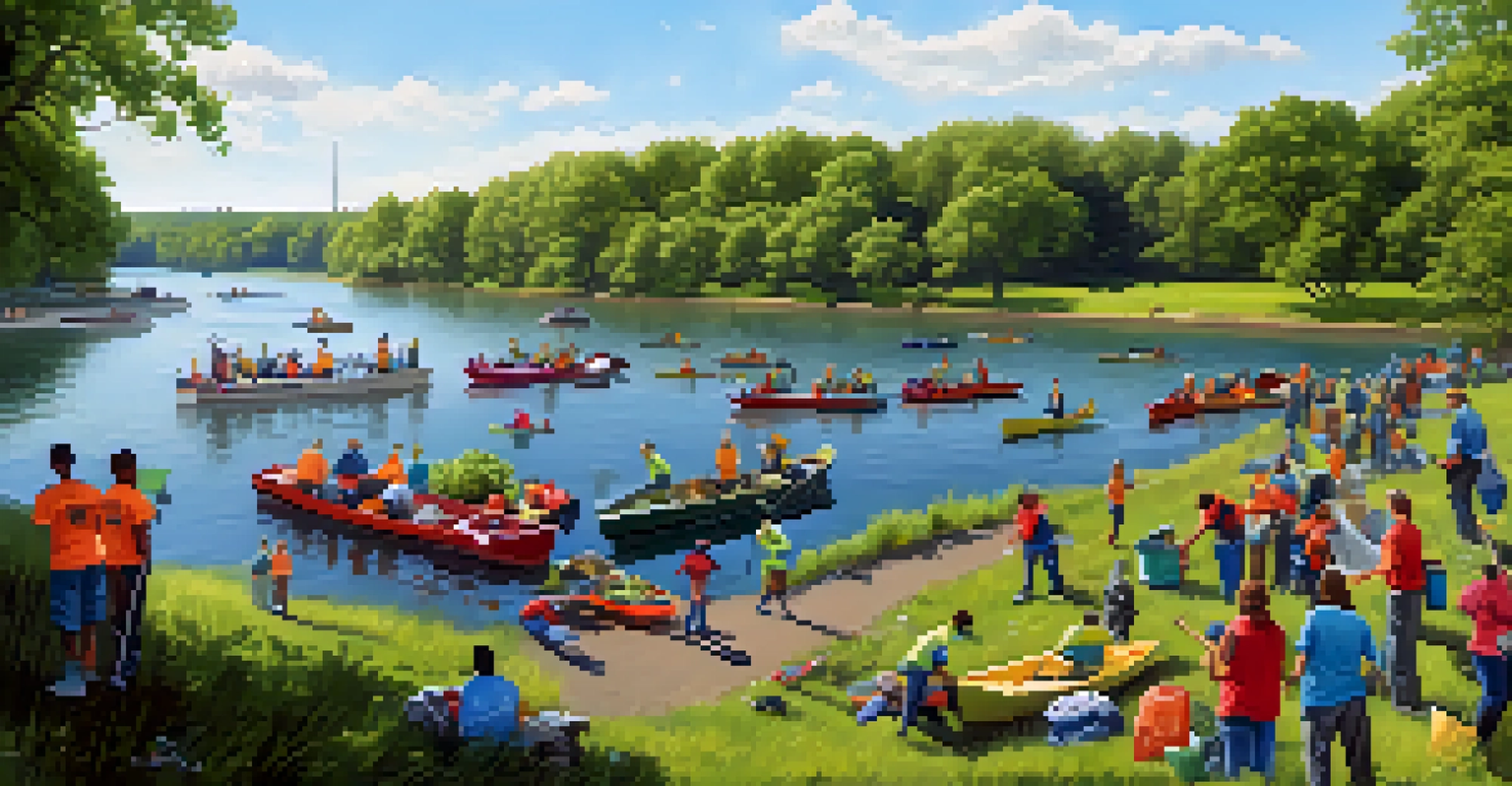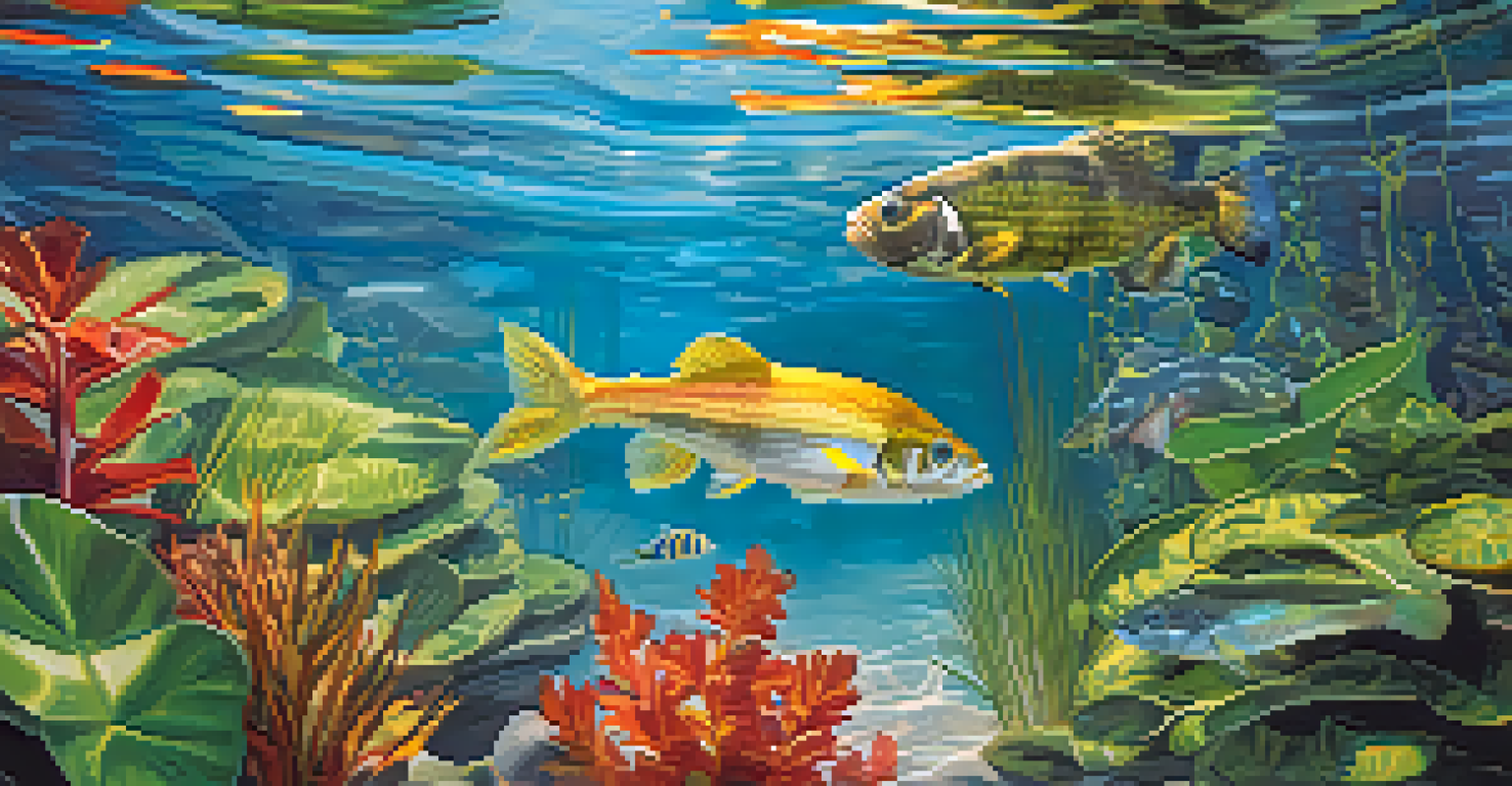Environmental Challenges Facing the Mississippi River Today

Pollution: A Major Threat to the River's Health
The Mississippi River is grappling with pollution from various sources, including agricultural runoff, industrial discharges, and urban waste. This contamination not only harms aquatic life but also poses risks to communities relying on the river for drinking water. For instance, excess nutrients from fertilizers can create dead zones, where oxygen levels are so low that fish and other marine life cannot survive.
We won't have a society if we destroy the environment.
Additionally, heavy metals and chemicals from industrial activities can accumulate in the riverbed, threatening the ecosystem and human health. When these pollutants enter the food chain, they can have devastating effects on wildlife and people who consume fish from the river. Addressing these pollution issues requires collaboration between governments, businesses, and local communities.
Efforts to combat pollution often include stricter regulations, waste treatment improvements, and community clean-up initiatives. However, success hinges on public awareness and active participation in conservation efforts. Educational campaigns can empower residents to understand the importance of keeping the river clean and encourage them to take action.
Climate Change: Altering the River's Ecosystem
Climate change is significantly impacting the Mississippi River, causing shifts in weather patterns, increasing temperatures, and more extreme events like floods and droughts. These changes disrupt the natural flow of the river and affect the habitats of countless species. For example, warmer water temperatures can lead to the proliferation of invasive species that outcompete native flora and fauna.

Moreover, rising sea levels threaten the river's estuaries, where freshwater meets saltwater. This transition zone is crucial for many fish species, and its degradation can have ripple effects throughout the ecosystem. The combined effects of climate change could lead to a decline in fish populations, impacting local fisheries and economies.
Pollution Threatens River Ecosystem
The Mississippi River faces severe pollution from agricultural runoff and industrial discharges, harming aquatic life and posing risks to communities.
To address these challenges, conservationists are advocating for sustainable practices that mitigate climate change and protect the river's ecosystem. This includes restoring wetlands, which can absorb excess water and provide habitats for wildlife. By understanding the interconnectedness of climate change and the health of the Mississippi River, we can better equip ourselves to combat these challenges.
Invasive Species: Disrupting Native Habitats
Invasive species pose a significant threat to the biodiversity of the Mississippi River. These non-native organisms, introduced by human activity, can outcompete local species for resources, leading to declines in native populations. For instance, the Asian carp, which has invaded the river system, poses a danger to local fish species and the fishing industry.
The river has great wisdom and whispers its secrets to those willing to listen.
The presence of invasive species can alter the food web, affecting everything from plankton to larger predators. This disruption not only impacts wildlife but also the livelihoods of those who depend on fishing and tourism. Communities along the river are feeling the effects as local fish populations dwindle, and ecosystems become unbalanced.
Efforts to control invasive species often involve both prevention and management strategies. Public awareness campaigns and regulations on the transport of aquatic species are critical in stopping the spread of invasives. Additionally, local organizations may engage in removal efforts to restore balance to the river's ecosystem.
Habitat Destruction: Impact on Biodiversity
Habitat destruction along the Mississippi River is another pressing environmental challenge. Urban development, agriculture, and industrial activities have led to the loss of wetlands and riverbanks, which are vital for many species. These habitats provide crucial breeding, feeding, and sheltering grounds for a variety of wildlife, including migratory birds and fish.
As these natural areas are altered or destroyed, the biodiversity of the river suffers. This decline can lead to increased vulnerability of species, making them more susceptible to disease and environmental changes. The loss of biodiversity not only affects the ecosystem but also diminishes the river's resilience against pollution and climate change.
Invasive Species Disrupt Biodiversity
Non-native species like Asian carp are outcompeting local fish, threatening the river's biodiversity and affecting the fishing industry.
Restoring habitats through reforestation and wetland restoration projects is essential for promoting biodiversity. These initiatives can help create a healthier ecosystem that supports both wildlife and human communities. By prioritizing habitat preservation, we can ensure a thriving Mississippi River for future generations.
Water Management: Balancing Needs and Conservation
Effective water management is crucial for addressing the environmental challenges facing the Mississippi River. The river serves multiple purposes, from providing water for agriculture and industry to supporting recreational activities and wildlife habitats. Striking a balance between these needs is essential for the river's health and sustainability.
Conflicts often arise when water levels fluctuate due to drought or heavy rainfall, impacting both human activities and natural ecosystems. For example, low water levels can hinder navigation and reduce agricultural irrigation, while high water levels can lead to flooding and erosion. Proper management strategies must consider these variations to mitigate potential impacts.
Collaborative efforts among stakeholders, including government agencies, local communities, and environmental organizations, are key to effective water management. By implementing sustainable practices and promoting responsible usage, we can work towards a healthier Mississippi River that meets the needs of both people and the environment.
Community Engagement: The Key to River Conservation
Community engagement plays a vital role in addressing the environmental challenges facing the Mississippi River. Local residents are often the first line of defense when it comes to monitoring and protecting their natural surroundings. By fostering a sense of stewardship, communities can work together to implement conservation practices and advocate for policies that benefit the river.
Educational programs and volunteer opportunities can help raise awareness about the river's importance and the challenges it faces. For instance, river clean-up events not only help to remove debris but also build a sense of community and connection to the waterway. Engaging residents in conservation efforts empowers them to take action and fosters a deeper commitment to protecting the river.
Community Involvement is Crucial
Local engagement and stewardship are essential for effective river conservation efforts, empowering residents to take action and advocate for the river's health.
Collaboration between community members, local organizations, and government agencies can amplify the impact of conservation efforts. By sharing resources, knowledge, and support, we can create a powerful network dedicated to safeguarding the Mississippi River for future generations. Together, we can make a difference.
Future Directions: Hope for the Mississippi River
While the Mississippi River faces numerous environmental challenges, there is hope for its future. Increasing awareness of these issues has led to more advocacy and action from various stakeholders, including governments, non-profits, and local communities. Innovative solutions and sustainable practices are being implemented to address pollution, habitat loss, and climate impacts.
Restoration projects, such as wetland rehabilitation and reforestation, are gaining traction and showing promising results. These efforts not only improve the health of the river but also enhance biodiversity and provide recreational opportunities for local residents. With continued support and investment, we can help revive the river and its surrounding ecosystems.

Ultimately, the future of the Mississippi River depends on our collective commitment to conservation and sustainable practices. By working together and prioritizing the health of this vital waterway, we can ensure that it remains a thriving ecosystem for generations to come. The Mississippi River's resilience is a testament to the power of collaboration and community action.